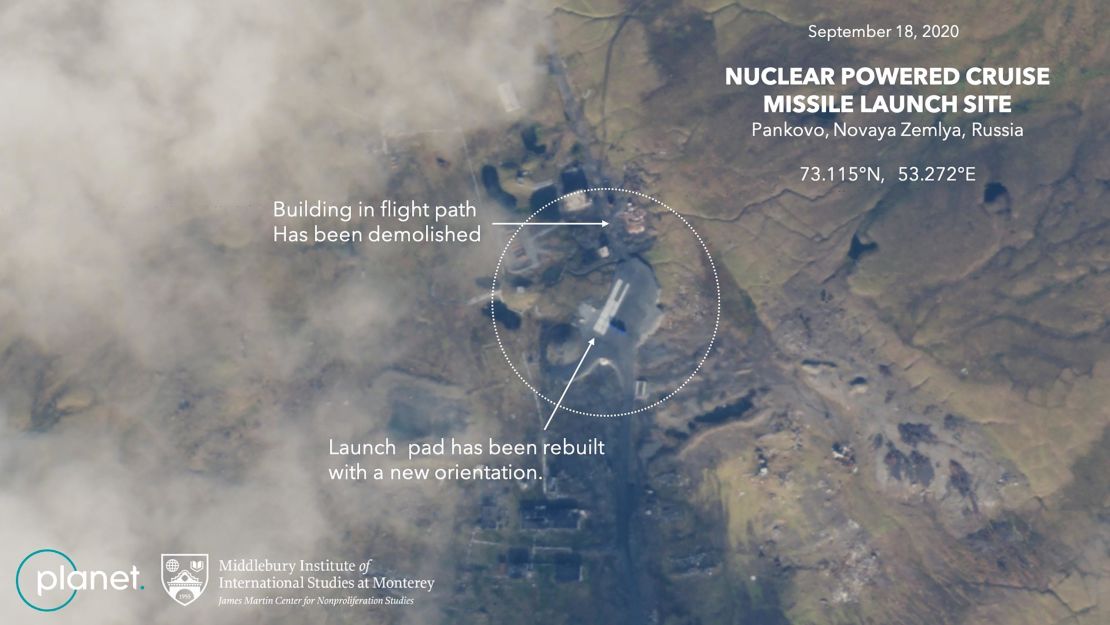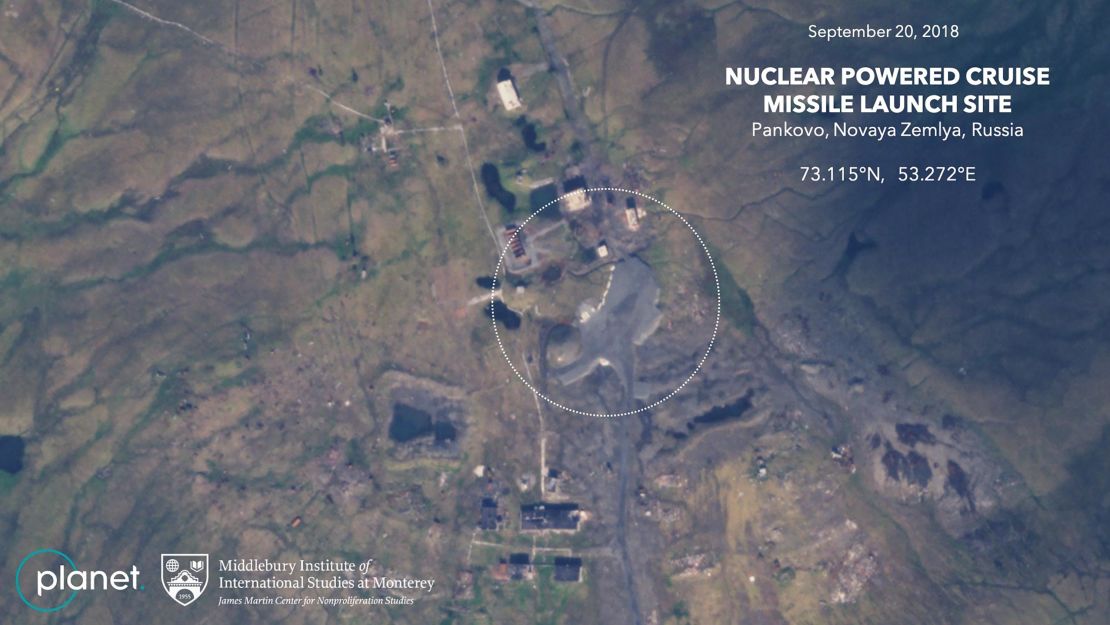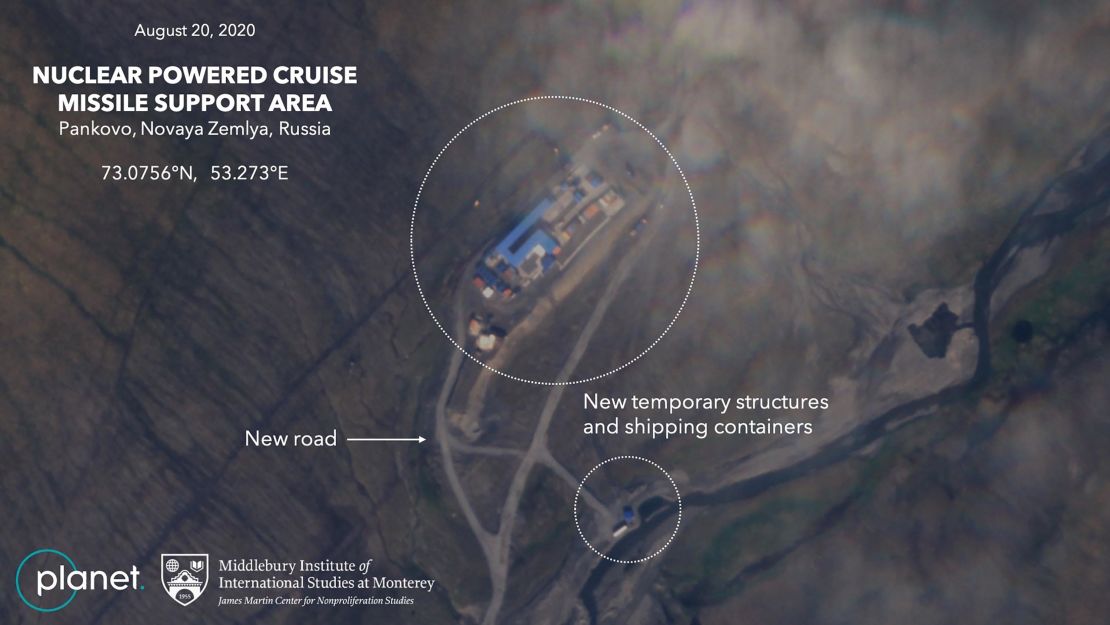New satellite images obtained by CNN indicate Russia is preparing to resume test flights of its nuclear-powered cruise missile at a previously-dismantled launch site near the Arctic Circle, according to experts who have analyzed the photos.
The images, captured by Planet Labs in September, show high levels of activity at a site known as Pankovo, previously used by Russia to test its Burevestnik nuclear-powered cruise missile, according to Michael Duitsman and Jeffrey Lewis, researchers at the Middlebury Institute of International Studies.
Russia appeared to pause testing of the missile after 2018, when it dismantled the launch site but “the new satellite photographs indicate that the pause is over,” they added.


“The activity and new construction are consistent with a resumption of test flights of the Burevestnik nuclear-powered cruise missile,” Lewis and Duitsman wrote in a new report, noting that the images show Russia has rebuilt the site’s launch pad and reveal “large numbers of shipping containers at two support areas, including the probable missile checkout building.”
Russia conducted at least one test flight of the nuclear-powered cruise missile from the same site near the Arctic Circle in November 2017. It reportedly carried out multiple other tests in the months that followed, though none were considered to be successful, according to Lewis and Duitsman.
In March 2018, Russian President Vladimir Putin released a video of a nuclear-powered cruise missile test, which allowed open-source researchers including analysts at the Middlebury Institute to identify the location, they added.
Two US officials told CNN that they are aware that Russia has been preparing to test missiles as part of its advanced weapons program.

Earlier this month, the Kremlin said it successfully test-fired a hypersonic cruise missile from a naval ship in the White Sea. And on Tuesday, Russia’s Ministry of Defense posted a video of Oniks cruise missile launch conducted from a military base in the Arctic.
MoD did not respond to CNN’s request for comment about whether there is an upcoming test of the Burevestnik missile.
Evidence that Russia may now be preparing to resume testing of its nuclear powered cruise-missile comes as Washington and Moscow are working to extend the New START treaty, a key arms control agreement that is set to expire in coming months.
The top US negotiator, Marshall Billingslea, suggested in a tweet Friday that talks between the two countries had reached an impasse.
But on Tuesday, Russia’s Foreign Ministry said it is willing to agree to freeze its nuclear arsenals in order to extend New START if the US does not pose any other requirements – an offer that the State Department spokesperson welcomed with urgency saying the US is “prepared to meet immediately to finalize a verifiable agreement.”
Trump has been urging his national security team to secure a nuclear deal with Russia before the November election, sources familiar with the efforts tell CNN. He had initially wanted to bring China into the deal, but China has repeatedly rejected partaking in any discussions.
While Russia has previously stated that its nuclear-powered cruise missile is not covered by the New START treaty, failure to extend the agreement could lead to the emergence of an arms race between the two countries, according to Lewis.
“The arms control framework that secured the post-Cold War has completely disintegrated. If and when the New START treaty expires in a few months, there will be no limits on US and Russian nuclear forces for the first time in fifty years. In its place is a burgeoning arms race as Russia develops one doomsday weapon after another to defeat US missile defenses,” he told CNN.
“The United States and Russia seem to be stumbling into a new arms race. This is one of a number of dangerous and destabilizing weapons right out of science fiction that Russia is developing to defeat US missile defenses,” Lewis added, referring to the nuclear-powered cruise missile.
For now, however, nuclear-powered cruise missile development is a way Russia can skirt the terms of New START and achieve intercontinental range that can pose a challenge to national missile defenses, according to Vipin Narang, a nuclear proliferation expert and associate professor at MIT.
“A nuclear powered cruise missile gives a low-flying, radar-evading, nuclear-capable missile intergalactic range that can pose a challenge to national missile defenses,” he told CNN, adding that indications Russia may be preparing another test show “how much our missile defenses drive their developments and how scared they are of them, not today, but tomorrow.”
They are also highly controversial “because it’s crazy to put an unshielded nuclear reactor on a missile to power it,” Narang added, noting that the consequences of testing this type of weapon can be catastrophic if something goes wrong.
That appeared to be the case in 2019 when, Russian state media said, five nuclear agency workers were killed in an explosion at a military test site in northern Russia.
The blast was detected by seismic stations and occurred during tests on a liquid propulsion system involving isotopes, the Russian Defense Ministry said. In other words, the test most likely had some nuclear dimension. And the reflexive secrecy of Putin’s government has only further fueled speculation about the cause of the accident.
At the time, Lewis told CNN that satellite imagery suggested that the incident might have been related to the testing of a nuclear-powered cruise missile.
CNN’s Ryan Browne, Kylie Atwood and Mary Ilyushina contributed to this report


